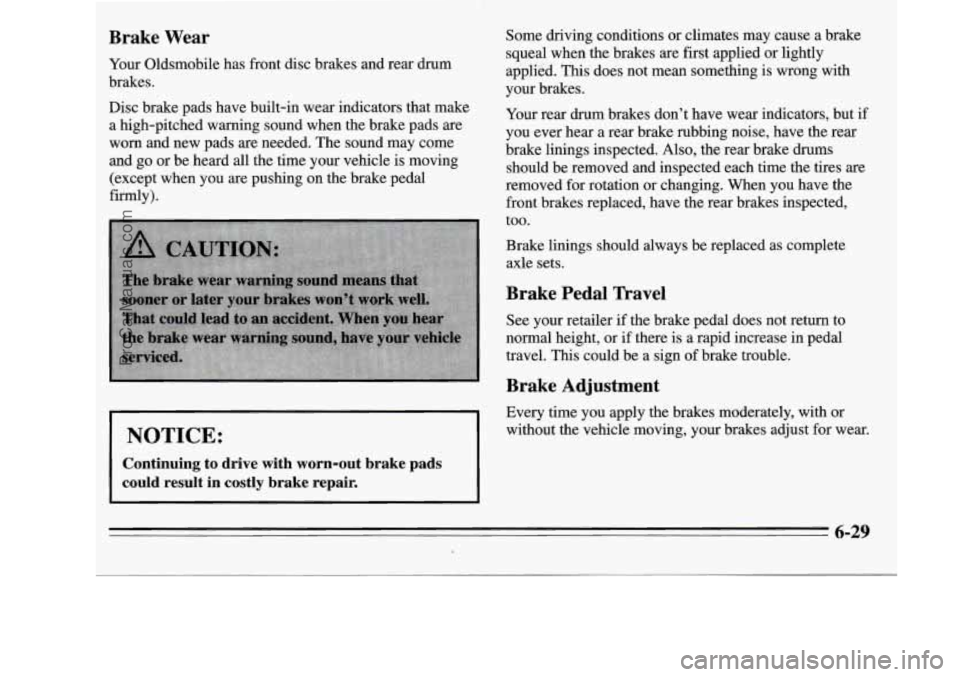height OLDSMOBILE SILHOUETTE 1995 Owners Manual
[x] Cancel search | Manufacturer: OLDSMOBILE, Model Year: 1995, Model line: SILHOUETTE, Model: OLDSMOBILE SILHOUETTE 1995Pages: 390, PDF Size: 20.27 MB
Page 50 of 390

Built-In Child Restraint (Option)
Each seat that has the built-in child restraint option fits in\
only one location in your vehicle.
To find out where a seat
that has a built-in child restraint must be located in your
vehicle,
see “Removable Rear Bucket Seats” in the Index.
11 you have a rear seat with the optional built-in child
restraint, refer to this picture to become familiar with the
parts
of each child seat and 5-point harness listed next.
A. Child Head Restraint
B. Head Restraint Release Strap C.
Shoulder Harness Straps
D. Shoulder Harness Clip
E. Removable Pad
E Seat Belt Latch Plates
G. Buckle
H. Seat Belt Buckle Release Button (Red)
I. Shoulder Harness Release Strap (Black)
J. Shoulder Harness Adjustment Strap (Gray)
K. Child Restraint Cushion
This child restraint system conforms
to all applicable
Federal motor vehicle safety standards.
This child restraint
is designed for use only by children
who weigh between
20 and 40 pounds (9 and 18 kg) and
whose height is
40 inches (102 cm) or less and who are
capable of sitting upright alone.
In addition, the child should be one year old or more and
at least 28 inches (71 cm) in height. It is important to
use an approved, rear-facing infant restraint for a full
year to allow the neck and spine to develop enough to
support the weight of the child’s head in the event
of a
collision.
1-40
ProCarManuals.com
Page 51 of 390

To make sure that the child is tall enough, compare the
child’s standing height to the top surface of the bucket
seat, which is about
29 inches (74 cm) from the floor. The
booster seat can be used by children over
40 pounds
(18 kg) or whose shoulders are above the shoulder belt
anchorages
of the 5-point child restraint harness. The
vehicle lap-shoulder belt is used instead
of the 5-point
harness system.
If a child’s shoulders are higher than the
shoulder belt anchorages while using the 5-point
harness, the spine could be injured in a collision.
WARNING! FAILURE TO FOLLOW THE
MANUFACTURER’S INSTRUCTIONS ON THE USE
OF THIS CHILD RESTRAINT
SYSTEM CAN
RESULT
IN YOUR CHILD STRIKING THE
VEHICLE’S INTERIOR DURING A SUDDEN STOP
1-41
ProCarManuals.com
Page 289 of 390

Brake Wear
Your Oldsmobile has front disc brakes and rear drum
brakes.
Disc brake pads have built-in wear indicators that make
a high-pitched warning sound when the brake pads are
worn and new pads are needed. The sound may come
and go or be heard
all the time your vehicle is moving
(except when you are pushing on the brake pedal
firmly).
NOTICE:
Continuing to drive with worn-out brake pads
could result in costly brake repair.
Some driving conditions or climates may cause a brake
squeal when the brakes are first applied or lightly
applied.
This does not mean something is wrong with
your brakes.
Your rear drum brakes don’t have wear indicators, but
if
you ever hear a rear brake rubbing noise, have the rear
brake linings inspected. Also, the rear brake drums
should be removed and inspected each time the tires are
removed for rotation or changing. When you have the
front brakes replaced, have the rear brakes inspected,
too.
Brake linings should always be replaced as complete
axle sets.
Brake Pedal Travel
See your retailer if the brake pedal does not return to
normal height, or if there is a rapid increase in pedal
travel.
This could be a sign of brake trouble.
Brake Adjustment
Every time you apply the brakes moderately, with or
without the vehicle moving, your brakes adjust for wear.
6-29
ProCarManuals.com
Page 301 of 390

1 NOTICE:
The wrong wheel can also cause problems with
bearing life, brake cooling,
speedometer/odometer calibration, headlamp
aim, bumper height, vehicle ground clearance,
and tire or tire chain clearance to the body and
chassis.
Used Replacement Wheels
Tire Chains
NOTICE:
Use tire chains only where legal and only when
you must. Use only
SAE Class “S” type chains
that are the proper size for your tires. Install
them on the front tires and tighten them
as
tightly as possible with the ends securely
fastened. Drive slowly and follow the chain
manufacturer’s instructions.
If you can hear the
chains contacting your vehicle, stop and retighten
them.
If the contact continues, slow down until it
stops. Driving too fast or spinning the wheels
with chains on will damage your vehicle.
6-41
ProCarManuals.com